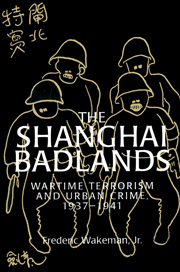Book contents
- Frontmatter
- Contents
- Dedication
- Acknowledgments
- Glossary
- Shanghai, 1940
- Metropolitan Shanghai
- Dedication
- Prologue: Consequences
- 1 Island Shanghai
- 2 Blue Shirts
- 3 National salvation
- 4 Retaliation: Pro-Japanese terrorism
- 5 Provocation: The Chen Lu assassination
- 6 Capitulation: The Xi Shitai assassination
- 7 The puppet police and 76 Jessfield Road
- 8 Terrorism and crime
- 9 Rackets
- 10 Terrorist wars
- 11 Dimout
- Epilogue: Outcomes
- Abbreviations
- Notes
- Bibliography
- Index
7 - The puppet police and 76 Jessfield Road
Published online by Cambridge University Press: 02 November 2009
- Frontmatter
- Contents
- Dedication
- Acknowledgments
- Glossary
- Shanghai, 1940
- Metropolitan Shanghai
- Dedication
- Prologue: Consequences
- 1 Island Shanghai
- 2 Blue Shirts
- 3 National salvation
- 4 Retaliation: Pro-Japanese terrorism
- 5 Provocation: The Chen Lu assassination
- 6 Capitulation: The Xi Shitai assassination
- 7 The puppet police and 76 Jessfield Road
- 8 Terrorism and crime
- 9 Rackets
- 10 Terrorist wars
- 11 Dimout
- Epilogue: Outcomes
- Abbreviations
- Notes
- Bibliography
- Index
Summary
If communications between the Shanghai Municipal Police and the Japanese Military Police were much more expeditious after the Craigie-Arita formula went into effect, International Settlement police and Chinese puppet police relations were increasingly strained. This was partly owing to the expansive growth of the Chinese police, which in turn reflected a widening of its jurisdiction outside of Shanghai proper. The extension occurred as a result of regular Japanese forces’ defeat or cooptation of Chinese loyalist guerrillas operating in the Shanghai suburbs.
Before March 1939 Fengxian district in Pudong, for example, was completely under the control of guerrillas. But after military forces under General Nakajima launched a one-month mopping-up operation, the district was cleared of resistance. The Japanese continued to station 120 troops from the Songjiang Garrison in Fengxian, but in May 1939 Mayor Fu Xiaoan ordered Shanghai police chief Colonel Lu Ying to establish a new branch bureau there at Nanqiao. The bureau had 220 constables armed with about 100 rifles of miscellaneous types, all under the command of Yin Zhongli, advised by a Special Services Section agent named Yamashita.
Meanwhile Shanghai city law enforcement personnel grew. By June 1939 the police bureau of the Shanghai city government comprised eleven branch bureaus, five police stations, and eight other police units (detective corps, garrison, reserve unit, river corps, training depot, police van, detention house, and police hospital) with a total roster of 5,662 men and women, an increase of 507 persons since April.
In July, the Shanghai police bureau enjoyed another increase in strength after Interior Minister Chen Qun ordered Chief Lu Ying to assume jurisdiction over Jiading prefecture and Chongming Island.
- Type
- Chapter
- Information
- The Shanghai BadlandsWartime Terrorism and Urban Crime, 1937–1941, pp. 80 - 92Publisher: Cambridge University PressPrint publication year: 1996



